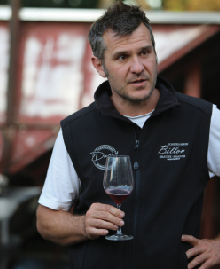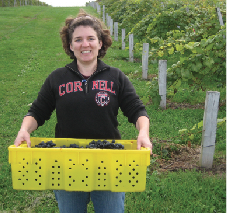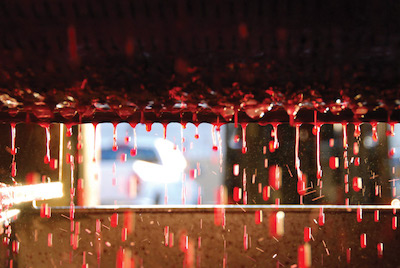Not all white wines should be treated equally when it comes to processing juice. Here are some helpful tips and insights winemakers should consider when they approach their next batch of white wine — when to go for a more oxidative approach to the juice and when to go for less.
 Associate Professor of Enology: Anna Katherine Mansfield, Cornell University
Associate Professor of Enology: Anna Katherine Mansfield, Cornell University
Hyperoxidation (highoxygen levels) has been getting a lot of hype recently. We generally use gas blanketing or SO2 additions to prevent oxidation prior to fermentation, but is it really necessary?
In must hyperoxidation, the idea is to get phenolic compounds in the must to oxidize, precipitate, and be removed from solution when the wine is racked. Research suggests that this will result in improved color stability and some reduction in bitterness and astringency. If the must is protected from oxidation during processing, the phenolic compounds that remain in the wine may oxidize later and produce undesired sensory characteristics, or just hang around and cause the unpleasant phenolic flavor characteristic in wines with some skin contact time. Also some phenolic compounds may play a role in odor degradation during wine aging, so removing them from the solution early in processing may slow changes in post-bottling aroma development (for better or worse!).
Phenolics, however, aren’t the only thing that can react with oxygen, and treating white wines with oxygen also affects desirable aromas – though exactly how, we aren’t sure. Most studies suggest that Chardonnay and Chenin Blanc show little or no aroma degradation following must hyperoxidation, but sensory evaluation of wines produced from aromatic grapes like Riesling and Gewürztraminer showed changes in aroma character, though not intensity. On the negative side, aldehydes that produced aromas described as “green” or “cucumber” have been reported to increase with must aeration, which could be unpleasant in more neutral cultivars. Also, it seems that many sulfur-containing compounds may be lost in the process, reducing the intensity of passion fruit/cassis/cat pee aromas in cultivars like Sauvignon Blanc, which rely on volatile thiols for varietal character.
In short, there are conflicting research results, and taking a hyperoxidative approach may not always be a good idea; you should approach your must processing as a case-by-case basis. It seems that some cultivars, like Chardonnay, can handle more oxygen during processing while other, more aromatic cultivars like Riesling or Sauvignon Blanc should be handled carefully. I’d also hazard to guess that a wine meant to be drunk young, when the fruity fermentation esters are prized, would be a bad candidate for oxygen exposure, while something meant for aging (like Chardonnay intended for malolactic fermentation and barrel exposure) would be more suitable for more oxidative handling.
On the extreme side of the hyperoxidation scale, there’s a recent surge of so-called “Black Chardonnay,” which draws from old Burgundian production methods. For this product, grapes are processed roughly, with heavy pressing and enough damage to tissue to release lots of phenolics – which precipitate from solution leaving a fuller-bodied, normal-colored wine. I recommend checking out this fascinating article on the topic: https://daily.sevenfifty.com/meet-black-chardonnay/.
 Winemaker: Todd Stevens, Neudorf Vineyards, Upper Moutere, New Zealand
Winemaker: Todd Stevens, Neudorf Vineyards, Upper Moutere, New Zealand
While I would not say that Neudorf Vineyards has any specific experience when it comes to micro-oxygenation on white wines nor have we ever trialed it, we are oxidative in style and embrace oxygen through many phases of the winemaking process. This is particularly the case throughout processing of the must and even post-fermentation. For example we use an open / slotted press to enhance oxygen exchange and no gas cover or sulfur dioxide is used at the juice tray or tank. If the fruit is healthy, then no sulfur will be added to the tank prior to fermentation. Conversely, in difficult years, an addition of sulfur may be added to the must. But often we will not add any. As a result the juice does “brown”, particularly towards the end of the cycle. We allow fermentations to be “wild” and therefore juice will sit unprotected until fermentation starts; typically 3-5 days.
Following fermentation we also sit on gross lees un-sulfured until the wine starts to show signs of tiring. This process can take some time. At this point a sulfur addition is made. However it should be noted that bottling is an exception where we are less tolerant of oxygen.
Our general philosophy is we feel the more oxidative handling helps with the phenolic management of the wine, instead of the use of fining agents. We also feel the wine is more stable and less likely to fluctuate when it eventually sees oxygen. In short, providing that we are not overly cavalier with our handling of the juice, we see oxygen as our friend and not as our foe.
 Associate Professor of Enology: Anna Katherine Mansfield, Cornell University
Associate Professor of Enology: Anna Katherine Mansfield, Cornell University





